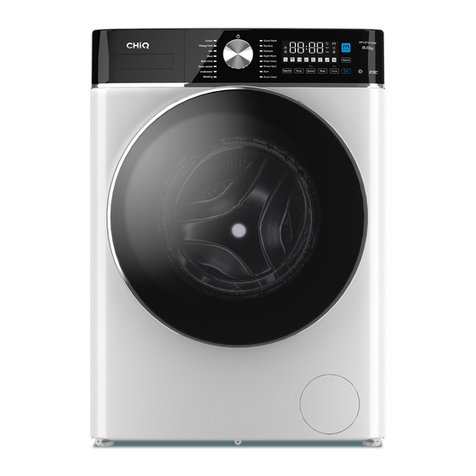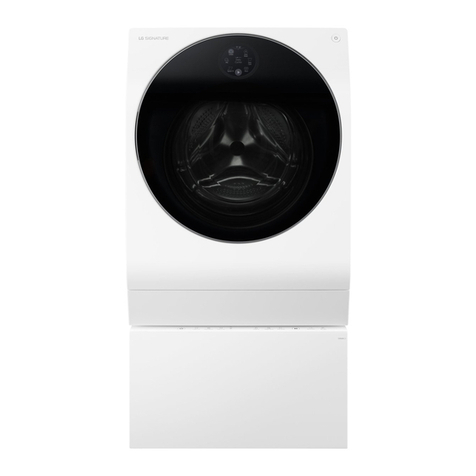ChiQ WFL8T48W2 User manual

MODEL
USER MANUAL
WFL8T48W2

Thank you for choosing CHiQbrand washing machine.
Before beginning installation, read these instructions carefully. This will simplify installation and
ensure that the product is installed correctly and safely. Leave these instructions near the
product after installation for future reference.
This manual may contain images or content different from the model you purchased.
This manual is subject to revision by the manufacturer.
Technical date
Model
WFL8T48W2
Rated washing capacity (kg) 8
Rated voltage 220--240V~
Rated frequency 50Hz
Rated power (W) 2000
Washing noise level (dB) 62
Spinning noise level (dB) 76
Spin speed (rpm) 1400
Water pressure (MPa) 0.03 ~1.0
Waterproofing grade IPX4
Water consumption
(litres per wash) 81
Energy consumption
(kWh per year) 308
Net weight (kg) 65
Outer dimension
(WxDxH mm) 600 X 577 X 847

1
Safety instruction. 2-3-4-5
Safety instruction
Disposal
Installation. 6-7-8-9
Unpacking,
Remove the transport bolts
levelling
Choosing the Right Location
Connecting the electricity and water supplies
Technical date
Description of the washing machine. 10-11
Control panel
Display
Preparing and sorting laundry. 12-13
Preparing the laundry
Sorting the laundry according to colour and degree of soiling
Sorting laundry according to their care label specifications
Wash cycles and options. 14-15
Table of wash cycles
M. Smart wash cycle
Special wash cycles
How to use the appliance. 16-17-18
Before loading your first load of laundry
Daily use
Preparing the laundry
How to use the washing machine
Care and maintenance. 19-20-21
Cutting off water and electricity supplies
Cleaning the appliance’s exterior
Cleaning the drum
Descaling the washer
Caring for the door and drum of your appliance
Checking the water inlet hose
Cleaning the detergent dispenser
Cleaning the water inlet strainers
Cleaning the drain pump
Troubleshooting. 22-23-24

Safety instruction
2
Before using the appliance, read these safety
instructions. Keep them nearby for future reference.
These instructions and the appliance itself provide
important safety warnings, to be observed at all
times. The manufacturer declines any liability for
failure to observe these safety instructions, for
inappropriate use of the appliance or incorrect
setting of controls.
Young children (0-3 years) should be kept away from
the appliance. Young children (3-8 years) should be
kept away from the appliance unless continuously
supervised. Children from 8 years old and above
and persons with reduced physical, sensory or
mental capabilities or lack of experience and
knowledge can use this appliance only if they are
supervised or have been given instructions on safe
use and understand the hazards involved. Children
must not play with the appliance. Cleaning and user
maintenance must not be carried out by children
without supervision. Keep all laundry aids (including
detergent, bleach, fabric softener, etc.) out of the
reach of children.
PERMITTED USE
CAUTION: The appliance is not intended to be
operated by means of an external switching device,
Such as a timer, or separate remote controlled
system.
This appliance is intended to be used in household
and similar applications, it is not in applications
such as: staff kitchen areas in shops, offices and
other working environments; farm houses; by
clients in hotels, motels, bed & breakfast and Areas
for communal use in blocks of flats or in
launderettes.
Do not load the machine above the maximum
capacity (kg of dry cloth) indicated in the program
table.
This appliance is not for professional use. Do not
use the appliance outdoors.
Do not use any solvents (e.g. turpentine, benzene),
detergents containing solvents, scouring powder,
glass or general purpose cleaner, or flammable
fluids; do not machine wash fabric that have been
treated with solvents or flammable liquids.
Do not machine wash fiberglass materials (such
as curtains and windows coverings that use
fiberglass materials). Small particles may remain in
the washing machine and stick to fabrics in
subsequent wash loads causing skin irritation.
Fabric softeners, or similar products, should be used
as specified by the fabric softener instructions.
Remove all objects from packets such as lighters and
matches.
Make sure there is no water in the drum before
opening the door.
Never wash the carpet in the washing machine.
Keep pets away from the washing machine.
Exercise caution when pumping out hot detergent
solution.
Do not fill water during washing cycle manually.
Please close the loading door correctly, if it is
difficult to close it, please check if the laundry is
caught in the door.
Water may reach very high temperatures during the
wash cycle.
Do not reach into the appliance if the wash drum is
moving.
Do not temper with the controls.
Never open the door forcibly or use it as a step.
Do not allow anyone to climb, lean or hang on any
part of the washing machine including any
protruding components such as the appliance door
or a pullout shelf.

Safety instruction
3
INSTALLATION
The appliance must be handled and installed by two
or more persons –risk of injury. Use protective
gloves to unpack and install –risk of cuts.
The washing machine must be installed and
operated in a room with a drain.
Installation, including water supply (if any) and
electrical connections and repairs must be carried
out by a qualified technician. Keep children away
from the installation site. After unpacking the
appliance, make sure that it has not been damaged
during transport. In the event of problems, contact
the dealer or your nearest After-Sales Service. Once
installed, packaging waste (plastic, Styrofoam parts
etc.) must be stored out of reach of children –risk
of suffocation. The appliance must be disconnected
from the power supply before any installation
operation –risk of electric shock. During installation,
make sure the appliance does not damage the
power cable –risk of fire or electric shock. Only
operate the appliance when the installation has
been completed.
Do not install your appliance where it may be
exposed to extreme conditions, such as: poor
ventilation, temperatures below 5 ℃or above
35℃.
Do not expose the washing machine in the place
with causticity or explosibility gas.(e.g. dust, steam
and gas, etc.)
Do not install the washing machine in a bathroom
or a room very wet.
The washing machine should not be installed in an
outdoor environment, not even where the area is
sheltered, because it may be very dangerous to
leave it exposed to damp, rain and thunderstorms.
When installing the appliance make sure that the
four feet are stable and resting on the floor,
adjusting them as required, and check that the
appliance is perfectly to level using a spirit level.
The appliance must not be installed behind a
lockable door, a sliding door or a door with a hinge
on the opposite side to that of the washer dryer, in
such way that a full opening of the washer-dryer
door is restricted.
Make sure that the ventilation openings in the base
of your washing machine (if available on your model)
are not obstructed by a carpet or other material.
When moving, do not lift the washing machine by
the knobs or detergent drawer, without lifting it by
the worktop or top lid; during transport, never rest
the door on the trolley.
The washing machine is fitted with transport bolts
to prevent any possible damage to the interior
during transport. Before using the machine, it is
imperative that the transport bolts are removed.
After their removal, cover the openings with the 4
enclosed plastic caps.
Connect the water inlet hose(s) to the water supply
in accordance with the regulations of your local
water company.
Use only the new hose-sets supplied with the
appliance to connect the appliance to water supply.
The old hose-sets should not be reused.
The supply water pressure must be in the
0.03—1MPa range,

Safety instruction
4
ELECTRICAL WARNING
It must be possible to disconnect the appliance from
the power supply by unplugging it if plug is
accessible, or by a multi-pole switch installed
upstream of the socket in accordance with the
wiring rules and the appliance must be earthed in
conformity with national electrical safety standards.
When the washing machine is installed, the mains
s o c k e t m u s t b e w i t h i n e a s y r e a c h .
Do not pull on the power cord or appliance to
unplug the machine.
When heating, the maximum current of the washing
machine is 10A, so please make sure that the power
supply system (voltage, current and the cable) is
applicable to the load of the applied appliance.
In order to ensure your safety, you must plug the
cable into a socket which connected to earth. And
please check your socket to make sure that it is
connected with reliable earth correctly.
Do not use extension leads, multiple sockets or
adapters.
The electrical components must not be accessible to
the user after installation.
Do not operate this appliance if it has a damaged
power cable or plug, if it is not working properly, or
if it has been damaged or dropped.
If the supply cord is damaged, it must be replaced
with an identical one by the manufacturer, its
service agent or similarly qualified persons in order
to avoid a hazard –risk of electric shock.
CLEANING AND MAINTENANCE
WARNING: Ensure that the appliance is switched off
and disconnected from the power supply and turn
off the water tap before performing any
maintenance operation; never use steam cleaning
equipment –risk of electric shock.
Use caution when draining hot water from the drum
such as during pump maintenance or when using
emergency door open procedure.
SERVICE
Do not repair or replace any part of the appliance
unless specifically stated in the user manual. Use
only authorized After-sales Service. Self or
non-professional repair may lead to dangerous
incident resulting in live or health threatening
and/or significant property damage.
In the event of fault and/or malfunction, turn off
the washing machine, close the water tap and do
not tamper with the machine. Immediately contact
the Customer Service Centre and only use original
spare parts.
Always unplug the washer-dryer from the power
supply before attempting any service. Disconnect
the power cord by grasping the plug, not the cord.
Before the appliance is removed from service or
discarded, remove the door to prevent children
from playing or hiding inside. Also remove the
power cord/plug.

Installation
5
DISPOSAL OF PACKAGE MATERIALS
The packaging material is 100% recyclable and is
marked with the recycle symbol .
The various parts of packaging must therefore be
disposed of responsibly and in full compliance with
local authority regulations governing waste
disposal.
DISPOSAL OF HOUSEHOLD APPLIANCES
This appliance is manufacture with recyclable or
reusable materials. Dispose of it in accordance with
local waste disposal
regulations. For further information on the
treatment, recovery and recycling of household
electrical appliances, contact your local authority,
the collection service for household waste or the
store where you purchased the appliance. This
appliance is marked in compliance with European
Directive 2012/19/EU. Waste Electrical and
Electronic Equipment (WEEE). By ensuring this
product is disposed of correctly, you will help
prevent negative consequences for the environment
and human health.
The symbol on the product or on the
accompanying documentation indicates that it
should not be treated as domestic waste but must
be taken to an appropriate collection center for the
recycling of electrical and electronic equipment.

Installation
6
Unpacking
1. Remove the washer from its packing.
2. Make sure that the washer has not been
damaged during the transportation process. If it
has been damaged, contact the retailer and do
not proceed any further with the installation
process.
Remove the transport bolts
CAUTION
DAMAGE TO THE APPLIANCE OR INJURY POSSIBLE
The machine is secured for transport with
transport bolts. Transport bolts that are not
removed can damage the drum during operation
of the machine, the washer will vibrate, and it
will be much noisier during spin cycles if the
transport bolts are not removed before use. Be
sure to remove all 4 transport bolts completely
before first use. Keep the transport bolts. If a
pedestal was purchased with the washer, it must
be installed first, prior to removing the transport
bolts. Please consult the pedestal installation
instructions.
In order to prevent transport damage during later
transport, be sure to re-install the bolts before
transport.
1. Undo the four transport bolts Aand remove
them.
2. Remove the four spacers B. They will fall to the
floor when you tip the machine.
3. Insert the four cover caps C which will be found
in accessory bag.
Keep all the parts in safe place: you will need them
again if the washing machine needs to be moved to
another location.
Packaging materials should not be used as toys for
children.
Leveling the washer
Importance of leveling the washer
Your new washer uses high spin speeds to remove
water at the end of the wash cycle. It is important
that your washer is level and that all four washer
feet press with equal pressure against the floor. This
will help assure the quietest, most vibration-free
use of your washer.
Follow these steps:
1. Install the washer on a level and solid surfaces.
Preferably in a corner of a room.
2. If the floor is uneven (or out of level ) adjust the
washer feet as required to level the washer. Do
not place anything under the washer feet to help
level the washer.
3. Extend the washer feet no more than is
necessary. The more the feet are extended, the
more vibration the washer will experience. Start
with the washer feet turned all the way in and
adjust each foot as necessary.
4. Use a bubble level to check the top of the washer
to make sure it is level side to side and front to
rear.
5. Press down on each corner of the washer top to
make sure the washer doesn’t “wobble”. There
should be no “give” or movement. All four
washer feet should press equally against the floor.
This is just as important as the washer being level
to prevent vibration.
6. When the washer is level and does not wobble,
lock the washer feet in place by tightening the
locknuts against the washer bottom. Be sure to
do this without changing the height of the foot
(hold the foot while tightening the locknut)

Installation
7
Procedure for adjusting the washer feet:
1. After determining which washer feet need to be
extended, have someone lift up on the washer
slightly to take pressure off the foot to be
adjusted.
2. Turn the grey plastic foot to extend it downward
as far as necessary to raise the corner of the
washer the correct amount to level the washer.
3. When the height of the foot is correct, use a 17
mm open end wrench to tighten the locknut
against the washer bottom. The locknut should
be tighten against the bottom of the washer to
lock the foot in place.
Choosing the Right Location
●Locations the appliance is not to be
installed
In a damp place or where the appliance may be
exposed to rain, etc.(As this could cause electric
shock or fire)
Locations that are uneven, or unstable (As this
could cause vibration and noise).
In direct sunlight (As this could cause malfunction
or deformation)
Within, or on top of, unstable surfaces, including
but not limited to benchtops, timber shelving, or
-
-
-
-
cabinets
!CANTION: Do NOT install where temperatures
may reach freezing
●Set-in Installation
Install the appliance with easy access to the
power plug and socket.
Install the appliance where there is enough space
around it.
-
-
(a) 3cm or more
above
5cm or more
behind
2cm or more on
the left side
2cm or more on
the right side
64cm or more
(b)
(c)
(d)
(e)
!CAUTION: Do NOT let metallic portions of the
appliance come into contact with metal sinks or
other appliances.

Installation
8
Connection the electricity and water
supplies
Connecting the water inlet hose
1. Connect one end of
the water inlet hose
by screwing it to a
cold water tap using a
3/4 gas threaded
connection (see
figure).
Before performing
the connection, allow
the water to run freely until it is perfectly clear.
2. Connect another
end of the water inlet
hose to the washing
machine by screwing
it onto the
corresponding water
inlet of the appliance,
which is situated on
the top right-hand
side of the rear part of the appliance (see figure)
3. Make sure that the hose is not folded over or
bent.
The supply water pressure must be in the
0.03—1MPa range, the values indicated in the
Technical date table (see page 8).
If the inlet hose is not long enough, contact a
specialized shop or an authorized technician.
Never use second-hand water inlet hoses.
Use the new water inlet hose supplied with the
machine.
Connecting the
drain hose
Connect the drain
hose, without
bending it, to a
draining duct or a
wall drain situated
between 65 and
100cm from the floor;
The drain hose may be
connected to an under
sink trap. Before
connecting the drain
hose from the machine
ensure that any blanks
or removable ends
have been taken off
the spigot,
If it is placed over the
edge of the basin or
sink be sure the free
end of the hose
should not be under
water tap.

Installation
9
Electric connection
Before plugging the appliance into the mains socket,
make sure that:
·The socket is earthed and in compliance with the
applicable law.
·The socket is able to sustain the appliance’s
maximum power load indicated on the Technical
Date Plate fixed on the machine.
·The supply voltage is included within the values
indicated on the Technical Date Plate fixed on the
machine.
·When heating, the maximum current of the
washer-dryer is 10A, so please make sure that
the power supply system (voltage, current and
the cable) is applicable to the load of the applied
appliance.
·The socket is compatible with the washer’s plug.
If this is not the case, replace the socket or the
plug by a qualified electrician.
WARNING----THIS APPLIANCE MUST BE EARTHED.
THE FOLLOWING OPERATIONS SHOULD BE
CARRIED OUT BY A QUALIFIED ELECTRICIAN.
Do not use extension cables, multiple sockets or
adapters.
To remove the plug from the socket, grasp the
plug firmly and pull it out. Do not pull at the cable.
The electrical components must not be accessible
to the user after installation.
Do not connect the machine to electrical outlets
while your hands are wet or damp.
Do not operate this appliance when you are wet or
barefoot.
Do not operate this appliance if it has a damaged
power cable or plug, if it is not working properly, or
if it has been damaged or dropped.
WARNING! The company denies all liability if and
when these norms are not respected.
The water consumption of a cold wash cycle is no higher
than a warm cycle.

Description of the appliance
10
Control panel
A---POWER button: Press and hold the POWER
button to turn the washer on or off.
B---PROGRAM button: Long press the power button
to start the washer, and then press the program
button to select the desired washing program (see
“Table of wash cycles”). The corresponding program
indicator flashes, and the display shows the
duration time of the selected program.
C---START/PAUSE button:
·Long press the button to start a wash cycle.
·Once the cycle has begun, if you want to pause
the wash cycle, please long press the button again.
If the DOOR LOCK symbol is not illuminated,
the door may be opened, you can add or take out
laundry.
To start the wash cycle from the point at which it
was interrupted, press the button again.
D---TEMPERATURE button: Press to change the
water temperature for the current cycle, with the
changed temperature value appears on digital
display.
E---SPEED button: Press to change the spinning
speed for the current cycle, with the changed
spinning speed value appears on digital display.
·CHILD LOCK function: When the cycle is running,
if you want to activate the control panel lock, please
press and hold the SPEED button for approximately
3 seconds. When the indicator light is
illuminated, the control panel is locked. This means
it is possible to prevent wash cycles from being
modified accidentally, especially where there are
children in the home.
To deactivate the control panel lock, press and hold
SPEED button for approximately 3 seconds.
·Cancelling the buzzer:
Press and hold the SPEED button and ONE TOUCH
button together at the same time for at least 3
seconds, you can turn off the buzzer that sounds
during the washing cycle running.
·To activate the buzzer setting
Do the same operation as you did for cancelling. The
buzzer setting is activated after one beep.
F---DIY TIME button: Press to change the program
time, the changed program time appears on the
digital display, and the wash program will run
according to the changed program time.
G---ONE TOUCH button: Press to set the
M-Smart wash cycle.
For a detailed description, see→Wash cycle and
options.
H---DELAY END button: Press to set the washer
to finish the selected wash cycle automatically at
later time. Choose a delay of 1 to 24 hours (in 1
hour increments).
The hour value appears on digital display indicates
the time the wash cycle will finish.
The way to cancel Delay End function:
·Press the “Program”button to reset the wash
cycle.
I---PROGRAM DISPLY AERA: By pressing the
program button to select the desired washing
program, the corresponding program indicator on
the program display area flashes, and the display
shows the duration time of the selected program.

Description of the appliance
11
M---Display
1---DELAY END indicator
The lit symbol indicates the DELAY END
function is activated. The countdown to
the end of the selected wash cycle will appear on
the digital display.
2---CHILD LOCK indicator
The lit symbol indicates the CHILD LOCK
function is activated, the control panel is
locked (apart from the OFF position on the control
panel).
3---DOOR LOCK indicator
The lit symbol indicates that the door is
locked. To prevent any damage, wait
until the symbol turns off before opening the door.
To open the door while a cycle is in progress, press
the START/PAUSE button, if the DOOR LOCK symbol
is switched off the door may be opened.
4---Temperature indicator
When a program is selected, the default
temperature value of this program will appears on
the display, with the corresponding temperature
indicator light illuminated.
You can change the temperature value by pressing
the TEMPERATURE button. If all temperature
indicator light are off, it indicated the washer using
only cold water without utilized the washer’s heater
in this program.
5---SPINNING SPEED indicator
When a program is selected, the
default spinning speed value of this program will
appears on the display, with the corresponding
spinning speed indicator light illuminated.
You can change the spinning speed value by
pressing the SPEED button. If all spinning speed
indicator light are off, it indicate the washer does
not spin after the final drain process in this
program.
6---ONE TOUCH indicator
The lit symbol indicates the M-Smart
wash program is selected. There are three ways to
set the M-Smart wash program.
7---DIGITAL DISPLAY
1) Wash cycle
remaining
time
2) Delay end time
3) Temperature
4) Spin speed
5) Fault code
The display is useful when programming the machine and provides a great deal of information.

Preparing and sorting the laundry
12
Preparing the laundry
Notice: Damage to the appliance/fabric
Foreign objects (e.g. coins, paper-clips, needles,
nails) may damage the laundry or components in
the washing machine.
Therefore, note the following tips when preparing
your laundry:
Remove any loose
items or metal objects,
such as safety pins,
paper clips, etc. from
the laundry.
Brush sand, coins, etc. out of pocket and cuffs.
Close zips and button
up cushion covers,
duvet covers, etc.
Remove curtain runners, or secure them in a net
bag.
Particularly delicate items; such as tights or lace
curtains, or smaller
items, such as tiny
socks or handkerchiefs,
should only be
washed in a net bag or
pillow case.
Some items are best
turned inside out.
These included
knitwear, trousers,
T-shirts and
sweatshirts.
Make sure that the wire-cup bras are machine
washable.
!Make sure that wire-cup bras in a pillow case
which can be securely closed with a zip or button.
If the wire works itself out of the cup it may fall
through the holes of the drum and cause
extensive damage.
Sorting the laundry according to
colour and degree of soiling
Sort laundry items according to color, degree of
soiling and recommended wash temperature range.
Items of clothing can become discoloured.
Never wash new muti-coloured items together
with other items.
Wash white items separately from colored items.
Otherwise, white items may tend to become
grey.
Degree of soiling
Light soiling
No visible soiling or stains, but may have
absorbed some odor. This could include light
weight summer clothes such as T-shirts, shirts, or
blouses worn only once. Also to freshen bed
linen or guest towels
Normal soiling
Visible soiling and/or a few light stains. This could
include clothing such as T-shirts, shirts, or
blouses that nave been sweated in or worn
several times. Also tea towels, hand towels or
bed linen used for up to one week or more.
Curtains without stains that have not been
washed for up to a half year.
Heavy soiling
Visible soiling and stains. This could include
kitchen towels, fabric napkins, baby bibs,
children’s outer clothing or football jerseys and
shirts stained with grass or dirt. It could also
include working clothes such as overalls and
jeans and other clothing worn for outside work
and activities.

Preparing and sorting the laundry
13
Sorting laundry according to their
care label specifications
The symbols on labels of your garments will help
you in choosing the suitable wash program, the
right temperature, wash cycles, and ironing
methods. Don’t forget to give a glance to these
useful indications!

Wash cycles and options
14
Table of wash cycle
Wash cycle
Temp.
℃
(Max)
Max.
Load
(kg)
Description
Kind of detergent
Detergents
softe
ner
Universal
Special
Cotton 60 8 For pure cotton clothes L / P --- O
Quick wash 40 1 For small amount or lightly soiled
garments L / P --- O
Spin --- 8 For clothes which just needs spin --- --- ---
Delicate 40 3 For washing delicate or soft
clothes L / P --- O
Baby care 85 5 For kid's wear L / P L O
Allergy care 85 3 For clothes that need to remove
mites and allergens. L / P --- O
Wool 40 1 For wool which can be washed by
machine --- L / P O
Bedding 60 5 For large items such as blankets,
curtains and bedspreads L / P --- O
Rinse +Spin --- 8 For clothes which just needs
rinse and spin --- --- O
Drum clean 85 --- For cleaning the drum, no clothes
in drum --- --- ---
M-Smart
40
5
Special cycle which can be
started simply by pressing the
ONE-TOUCH button once.
L / P
---
O
L=gel-/liquid detergent P=Powder detergent O=Optional ---=No
If using liquid detergent, it is not recommended to activate the time delay.
Please follow the dosage recommendation on the powder or liquid detergent package.
We recommend by using:
Laundry powder 20℃to 80℃
Wool detergent 20℃to 40℃
Cotton, 40℃, 1400rpm and the intense option selected is recommended water and energy saving cycle for
normally soiled, everyday washing.
The detergent dosage: rated capacity*12.5g*75% and anti-foam aid is 16g.
Detergent dissolvent method: Dissolve the detergent first and pour the dissolved detergent into the machine
when the main wash starts.

Wash cycles and options
15
M-Smart wash cycle
M-Smart wash cycle can intelligently detect the
weight of laundry and match different washing time
and temperature to realize intelligent washing.
" " is displayed in the detection stage after
the cycle is started, and the M-Smart wash cycle can
be entered by the following three methods.
·When the washer is OFF, press and hold the
ONE-TOUCH button for at least 3 seconds, the
washer will run the M-Smart wash cycle directly,
with M-Smart indicator light illuminated.
·When the washer is ON, press and hold
ONE-TOUCH button for at least 3 seconds, the
washer will run the M-Smart wash cycle directly,
with M-Smart indicator light illuminated.
·When the washer is ON, short press the
ONE-TOUCH button, the M-Smart indicator light
illuminated, and then press the
START/PAUSE button, the washer runs the
M-Smart wash cycle.
Special wash cycles
Baby care: acycle designed for dirt typical of
children’s garments in that it effectively removes
any traces of residual detergent.
Down Jacket: a cycle to wash single downs (the
weight of which should not exceed 2.0kg), cushions
or clothes padded with goose down such as puffa
jacket, use this special wash cycle. We recommend
that down are placed in the drum with their edges
folded inwards (see figure) and that no more than
3/4 of the total volume of the drum is used. To
achieve the best results, we recommend that a
liquid detergent is used and placed inside the
detergent dispenser drawer.
Wool: all wool garments can be washed using this
wash cycle, even those carried the “hand-wash only”
label. For best results, use special detergent and do
not exceed 1.0kg of laundry.
Wash options
! If the selected option is not compatible with the
set wash cycle, the indicator light will flash and the
option will not be activated.

How to use the appliance
16
Before loading your first load of
laundry
Your new washing machine was tested before
leaving the factory. This process involves running
various wash cycles. As a result, a small amount of
water may remain in the tub and drainage system.
Run a Drum Clean cycle with no laundry to clean
the system before your first load of laundry.
First add 1 to 2 tablespoons of detergent to the
chamber I. Then run the Drum Clean cycle.
Wait for the cycle to finish.
Daily use
Preparing the laundry
EMPTY POCKETS
·Coins, paper clips, etc. could damage the load
and the washing machine components.
·Tissues will break down during the wash cycle
and the fragments will have to be subsequently
removed by hand.
CLOSE ALL ZIPPERS, BUTTONS, AND HOOKS. TIE
ALL RIBBONS OR BELTS
·Insert the smaller garments (e.g. nylon hosiery,
belts, etc.) and garments with hooks (e.g.
braziers) into a fabric bag or a pillowcase with
zipper. Remove any rings from curtains, or else
place the curtains inside a fabric bag together
with the rings.
FABRIC TYPE/SYMBOL ON THE WASH LABEL
·Cottons, mixed fibres, easy care/synthetics, wool,
hand wash items.
·Color
Separate colored and white items. Wash new
colored articles separate.
·Size
Wash items of different sizes in the same wash
load, to improve washing efficiency and
distribution of the articles in the drum.
·Delicates
Wash delicate items separately; they require
gentle treatment.
How to use the washing machine
1. Load laundry
Open the door and load the laundry. Load the
articles one at a time loosely into the drum,
without overfilling. Observe the load sizes given
in the “Table of wash cycle”, Overloading the
machine will result in unsatisfactory washing
results and creased laundry.
2. Close door
Make sure that no laundry gets stuck between
door glass and rubber seal. Close the door so that
you can hear it click shut.
3. Open water tap
Make sure that the washing machine is
connected to the water mains. Open the water
tap.
4. Set the desired program
Select the required program by pressing the
“Program”button. The duration of the wash
cycle is shown on the display. The washing
machine automatically displays the default
temperature and spin speed settings possible for
the selected program. Adjust the temperature
and/or spin speed setting if needed with the
relative buttons.
·Change temperature, if needed
Press the “Temperature” button to progressively
lower the temperature setting until cold wash
has been set (“—“will be shown on the display).
Pressing the button again sets the highest
possible setting.
·Change spin speed, if needed
Press the “spin” button to progressively decrease
the spin speed until the spin cycle is turned off
(“---” will be shown on the display). Pressing the
button again sets the highest possible setting.
·Select options, if needed
Press the button to select the option; the
respective symbol on the display illuminates.
Press the button again to cancel the option; the
light extinguishes.

How to use the appliance
17
!If the selected option is incompatible with the
program set, the incompatibility will be signaled by
a buzzer and the corresponding indicator light will
flash.
!If the selected option is incompatible with another
previously set option, only the most recent
selection will remain active.
5. Add detergent
Pull out the detergent dispenser and add
detergent (and additives/softener) into the
relative compartments as described below.
Compartment 1:
Powder washing
detergent
Compartment 2:
Liquid washing
detergent
The liquid detergent
must not exceed the
“MAX” level.
Compartment 3:
Additives (Softener. etc.) The fabric softener must
not exceed the “MAX” level.
Observe the dosing recommendations on the
detergent pack.
Correct dosing of detergent/additives is important,
because:
·It optimizes the cleaning result
·It avoids irritating residues of surplus detergent
in your laundry
·It saves money by avoiding waste of surplus
detergent
·It protects the washing machine by avoiding
calcification of components
·It respects the environment by avoiding
unnecessary environmental burden.
! Do not use hand washing detergents because
these create too much foam.
! Use powder detergent for white cotton garments,
for pre-washing, and for washing at temperatures
over 60℃.
! Follow the instructions given on the detergent
packing.
6. Delaying the end of a program
·To set a program to end at a later time, see the
section “Control panel / DELAY END”.
7. Start program
·Press the “Start/Pause”. The relative
indicator lamp illuminates, the door locks and the
“Door locked”indicator lights up.
·To avoid overflow, do not open the detergent
dispenser during a running program anymore.
·The remaining program duration can vary. Factors
like unbalance in the wash load, or foam
formation, can have an effect on the program
duration.
8. Change the settings of a running program, if
needed
You can still change the settings while a program
is running. The changes will be applied, provided
the respective program phase has no finished
yet.
To change the settings of a running program:
·Press “Start/Pause”to put the running
program on pause.
·Change your settings.
·Press “Start/Pause”again to continue the
program.
If you have changed the program, do not add
detergent for the new program.
To prevent that a running program is changed by
accident (for instance by children), use the
“CHILD LOCK”(see section “Control panel /
SPEED”).

How to use the appliance
18
Pause a running program and open the door, if
needed
Press “Start/Pause”to pause a running
program.
Provided water level or temperature is not too high,
the “Door lock”indicator light turns off. You
can open the door, for example to add more laundry,
or to remove laundry which was loaded by mistake.
Press “Start/Pause”to proceed with the
program.
9. Cancelling a running program, if needed
·Press the “Power”button to switch the
washing machine off.
·If the water level and temperature are low
enough, the door unlocks may be opened.
·The door remains locked if there is water in the
drum. To unlock the door, switch the washing
machine on, select the “Spin”program and turn
the spin option off by setting the spin speed to
“--”.
·The water is emptied and the door unlocks at the
end of the program.
10. Switch off the washing machine after
program End
·At the end of the cycle, the message “End”is
shown on the display.
·The door can only be opened when the symbol
“Door locked”light turns off.
·Check that the “Door locked”indicator is off,
then open the door and take out the laundry.
·Press “Power”button to switch the
washing machine off.
Leave the door ajar to let the interior of the washing
machine to dry.
Table of contents
Other ChiQ Washer manuals
Popular Washer manuals by other brands

Bosch
Bosch WM16XKH1EU User manual and assembly instructions
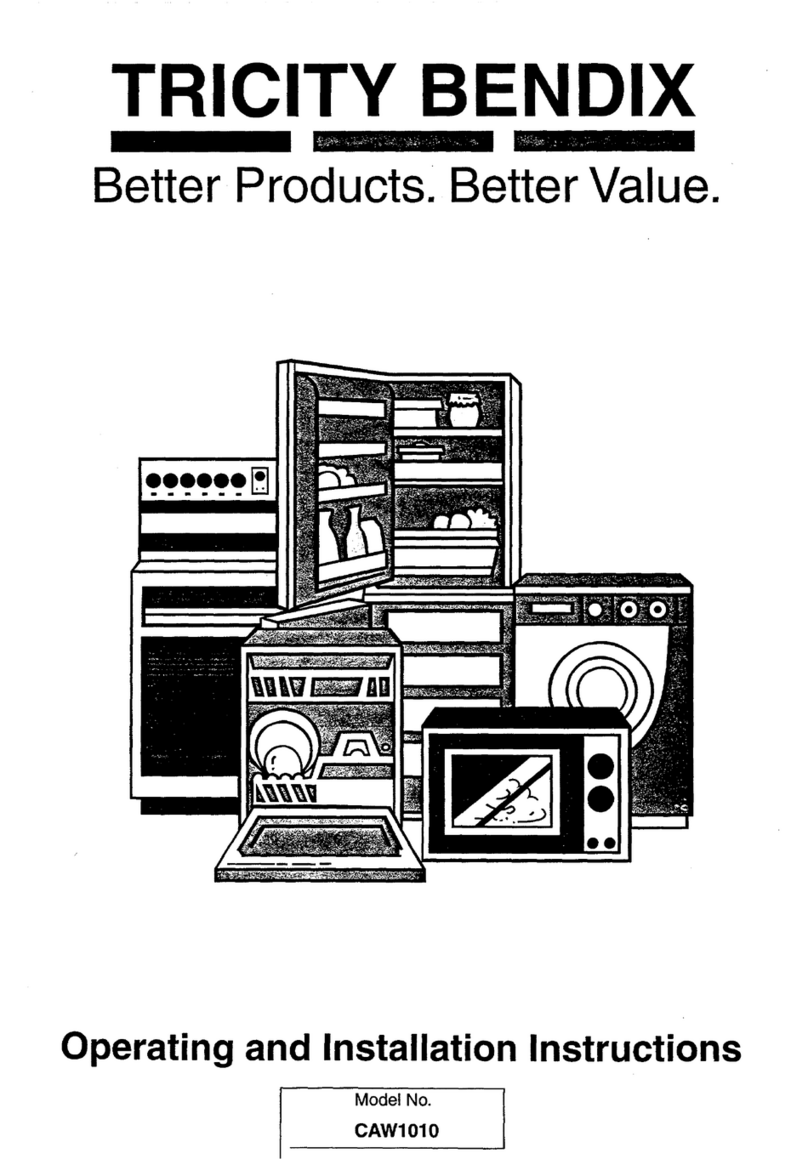
Tricity Bendix
Tricity Bendix CAW1010 Operating and installation instructions

Whirlpool
Whirlpool WFW8300S Installation information
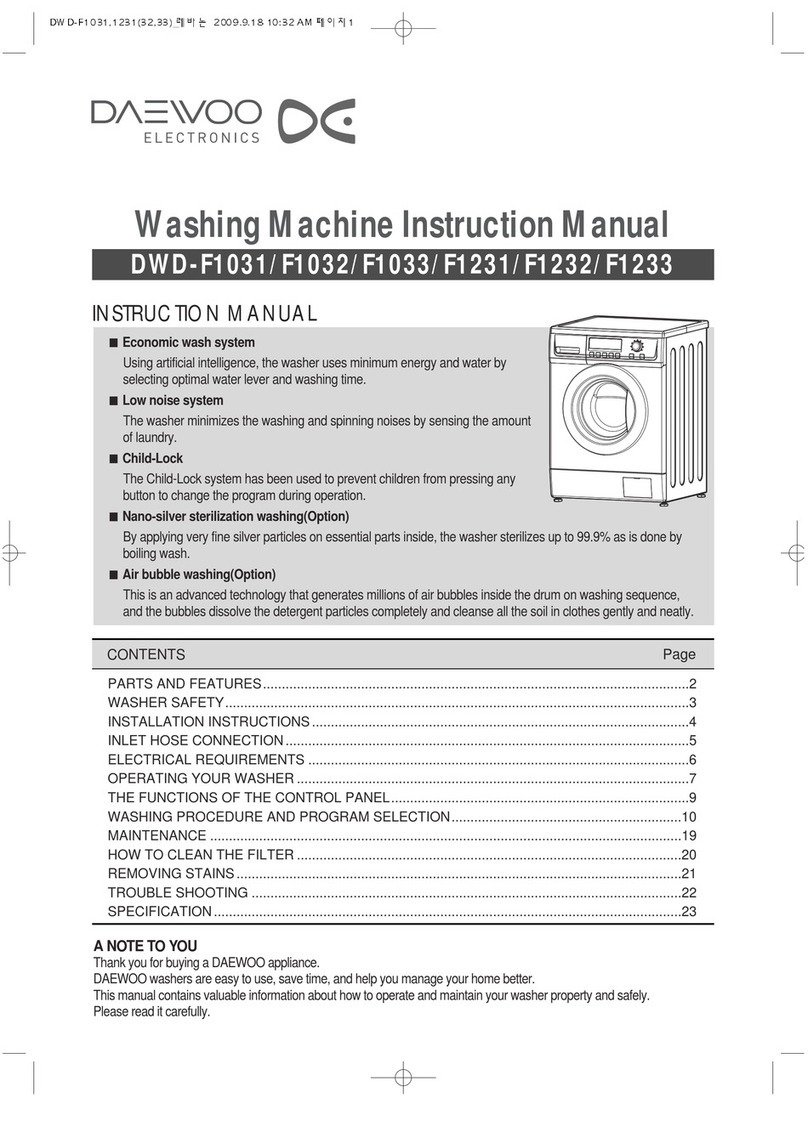
DAEWOO ELECTRONICS
DAEWOO ELECTRONICS DWD-F1031 instruction manual
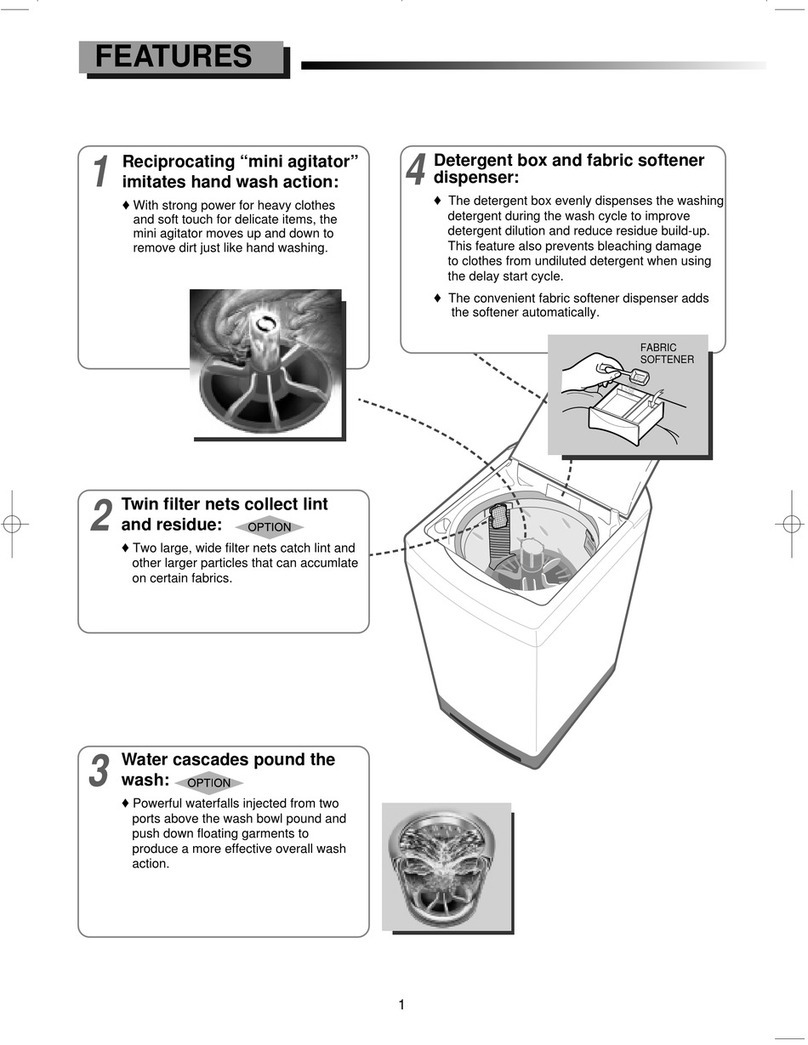
Samsung
Samsung SW55APP2 Owner's instructions
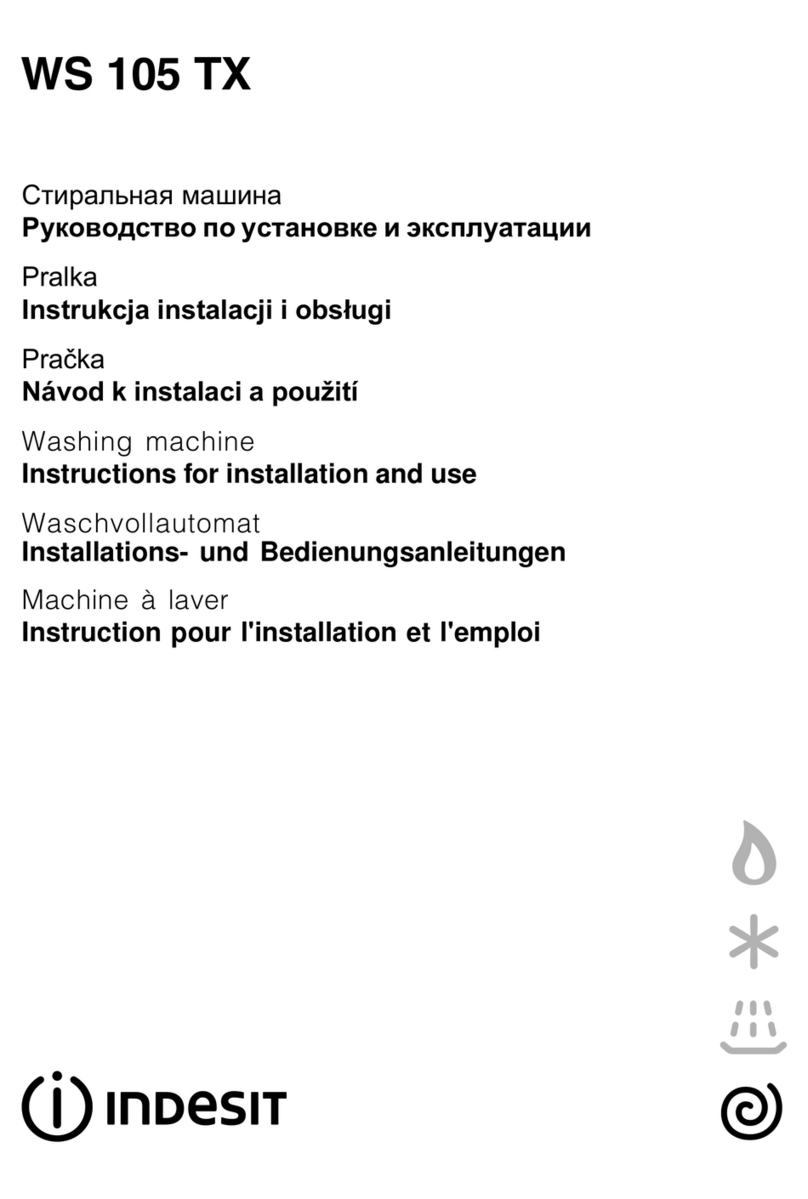
Indesit
Indesit WS 105 TX Instructions for installation and use
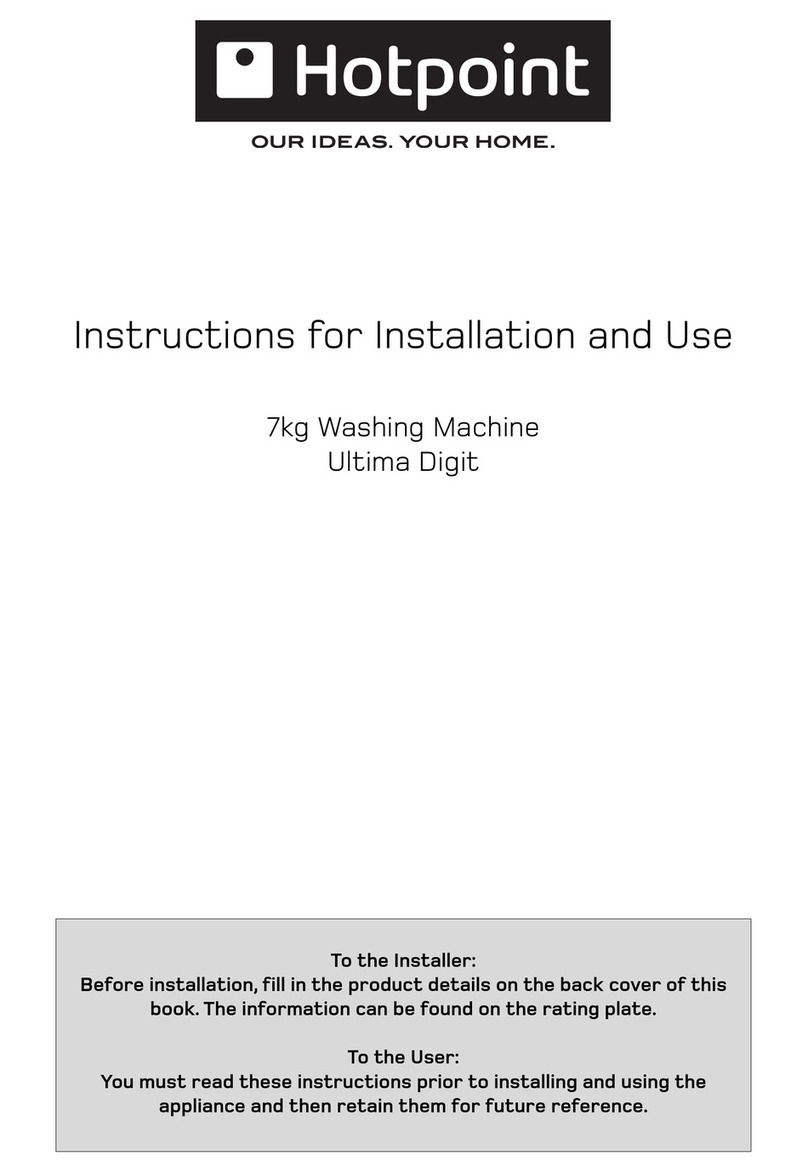
Hotpoint
Hotpoint Ultima Digit WT761 Instructions for installation and use

Miele
Miele WXI 860 WCS Operating and installation instructions

Philco
Philco PL 1062 CHIVA user manual

Hughes
Hughes STD-28G Installation, operation and maintenance instructions

Samsung
Samsung WW60J3283 USEFUL TIPS
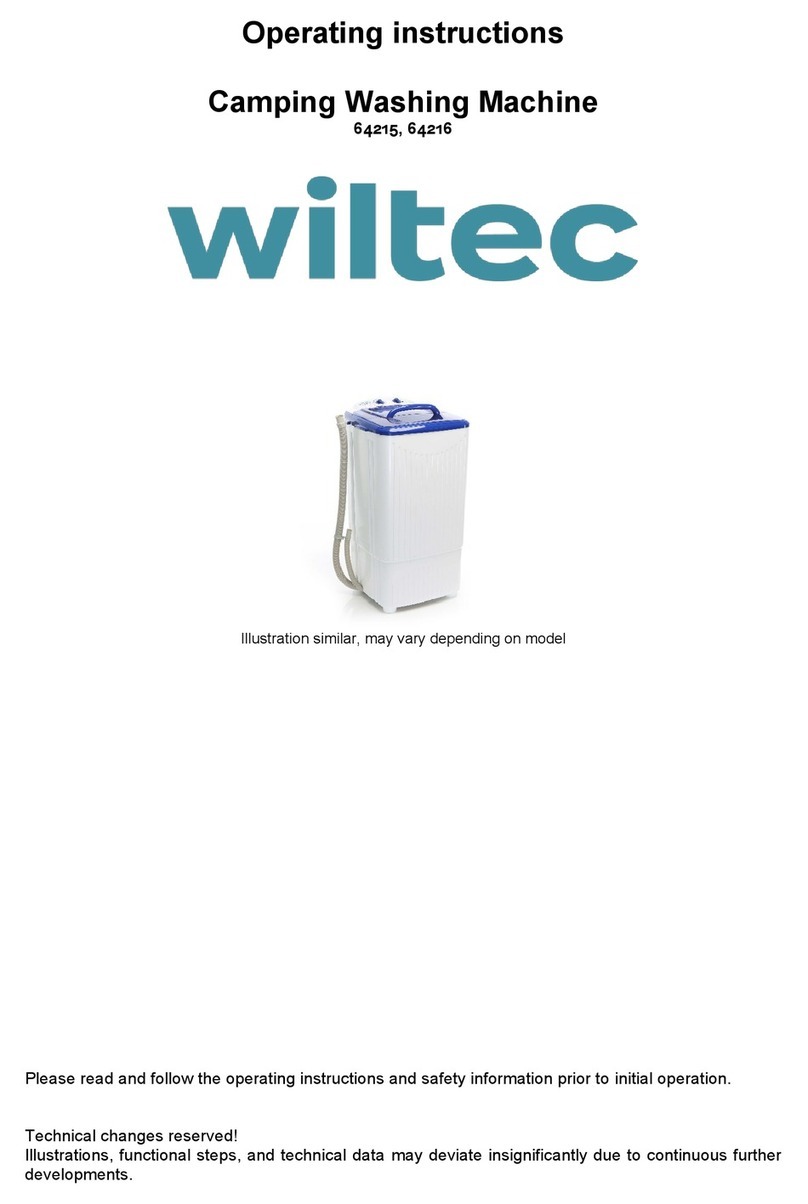
WilTec
WilTec WT-7000 operating instructions
